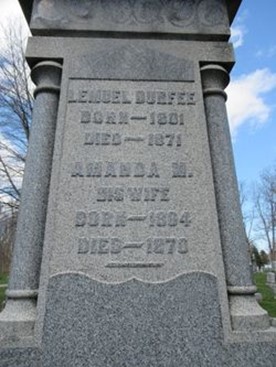
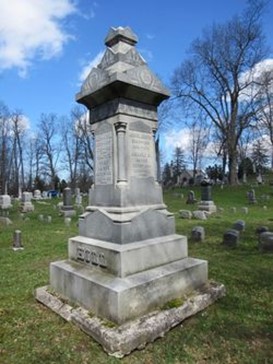
Lemuel Durfee Jr., the ninth of twelve children born to Lemuel Durfee Sr. and Prudence Hathaway, was born at 2 a.m. on March 1, 1801 in Palmyra, New York. [1] He was four years older than Joseph Smith Jr. Ten of Lemuel Jr.’s siblings resided in the greater Palmyra area throughout their lives. The reason for this was threefold:
1) The Durfee children enjoyed familial ties. They were the third generation of Durfees in the area.
2) They received land in the greater Palmyra area from their father Lemuel Sr. who inherited land from his father, Gideon Durfee. The land was given to the children before and after the death of Lemuel Sr.
3) They were raised Quakers. There was a large assembly of Quakers in the area. A Quaker meetinghouse was built on Lemuel Sr.’s property. The Quaker burial ground was also located on his property.
The Youthful Lemuel Jr.
Lemuel Sr. had a home built at the intersection of Maple Avenue and Jeffrey Road. In this house, Lemuel Jr. was reared to manhood. The nearest neighbors of Lemuel Jr. were his uncles, aunts, cousins, and the Martin Harris family. What these neighbors had in common besides Quakerism was farming, tilling the land, running businesses on their property, and raising small farm animals.[2]
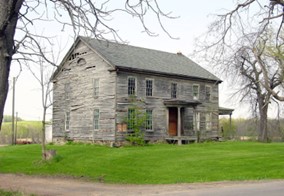
In his youth, Lemuel Jr. was expected to help prepare for market produce grown on the Durfee farms. Much of the produce was shipped to Schenectady via the Ganargua Creek and other waterways, including the Erie Canal. Lemuel Jr. was also expected to work at the Durfee Rope Walk—a long building where men and boys walked its length to twist hemp into rope. The rope was exported throughout the eastern United States.[3] In addition, Lemuel Jr. helped operate the Durfee Cider Mill. By so doing, he became acquainted with customers who were not Quakers, such as Alexander McIntyre, Eli Seymour, Pliny Sexton, Jeremiah Hurlbut, Henry Jessup, and Gain Robinson (suspects who were members of the Western Presbyterian Church). Lemuel Jr. also became acquainted with common laborers who had dealings with his father, such as Joseph Smith Jr., Hyrum Smith, and Samuel Harrison Smith.
Marriage
On June 4, 1823, Lemuel Jr. married Amanda M. Smith in Farmington, New York, the hub of Quakerism.[4] (Amanda had no ties to the Joseph Smith Sr. family). Amanda was the fifth of six children born to Jonathan Smith and Huldah Willmarth. In 1790, her parents moved to Farmington, New York from Adams, Berkshire County, Massachusetts. Amanda was raised a Quaker. Before her marriage, she resided in a large frame house with her family, where town meetings were held until it burned to the ground. Amanda’s twelve year old brother perished in the flames.
No children were born to the union of Lemuel Jr. and Amanda Smith. They adopted one child, Wealthy C. Wright (Durfee). Wealthy was born about eight years after Lemuel Jr. and Amanda Smith married. Wealthy lived all her days in the greater Palmyra area.
The Smith Farm and Lemuel Durfee Jr.
Lucy Mack Smith wrote of circumstances surrounding the loss of the Smith farm in 1825 and of Lemuel Sr. purchasing the farm. She also wrote of Lemuel Jr. being present during the property transaction on December 20, 1825. Lucy wrote of her husband, Joseph Smith Sr., starting—
Without delay for Mr. [Lemuel] Durfee’s, and arrived at his house before daylight in the morning. He sent my husband three miles further, to one of his sons, who was a high sheriff [Lemuel Durfee Jr.], instructing him to say to the young man that his father wished to see him as soon as possible. Mr. Durfee, the younger, was obedient to the call.[5]
Let us examine the Lucy Mack Smith statement. She referred to Lemuel Jr. as a “high sheriff.” The term “high sheriff” means the “highest official in a county or shire in England or Wales who represented the king or queen and attended ceremonies and had legal duties.” The phrase lost some of its meaning in Western New York, yet it still meant that Lemuel Jr. was the county sheriff and as such was given more respect than the local sheriff in Palmyra. The fact that Lemuel Jr. held this position of trust was most unusual for a Quaker. The Quakers of Palmyra usually took a backseat in civic affairs. They accepted civic positions such as overseers of highways, meaning they were willing to ensure fence posts and roads in their neighborhood were maintained. For Lemuel Jr., to be selected as a “high sheriff” at age twenty-four was unusual for a Quaker.
Lucy Mack Smith also wrote of Joseph Smith Sr. going “three miles further, to one of his sons.” Lemuel Sr. had sons whose properties bordered his, like his eldest son Isaac Durfee. Yet Father Smith was sent three miles from the Durfee home to fetch Lemuel Jr., who was living on a farm owned by his father in Macedon, a four mile distance from Palmyra. The farm was surveyed by George Crane, a Quaker mentioned in the 1870 Fayette Lapham article.
Lucy Mack Smith also wrote that Joseph Smith Sr. was instructed to “say to the young man that his father wished to see him as soon as possible. Mr. Durfee, the younger, was obedient to the call.” The fact that Lemuel Jr. dropped everything to help his father in a land transaction indicates that he was his father’s right-arm man. It also suggests that other sons were not as willing to help their aging father.
Continuing with the Lucy Mack Smith statement—
Immediately after he [Lemuel Jr.] arrived at his father’s, the three proceeded together to see the [Smith] farm, and arrived about ten o’clock a.m. They tarried a short time, then rode on to see the agent [at the county seat of Canandaigua] and those villains who held the deed of our place.[6]
On December 20, 1825, Lemuel Sr., Lemuel Jr., and Joseph Smith Sr. went to Canandaigua, where Lemuel Sr. purchased the Smith farm for $1,135.25 Under Lemuel Sr.’s ownership, the Smiths became “renters,” being allowed to use the farm and remain in the frame home.[7] According to Lucy Mack Smith, Lemuel Sr. “gave us the privileage [sic] of the place one year with this provision that Samuel our 4th son was to labor for him 6 months.”[8]
On July 12, 1826, seven months after acquiring the Smith property, Lemuel Sr. specified in his Last Will and Testament that eight of his children—one being Lemuel Jr.—were to inherit the Smith farm:
The lot of land called the Execution lot situated in the north West corner of the town of Manchester in the county of Ontario being the lot on which Joseph Smith now lives containing about one hundred acres of land . . . to be distributed as follows amongst my heirs (viz) the third thereof to be equally distributed among my four sons Isaac, Oliver, Lemuel and Bailey and the remaining third to be distributed among my four daughters Phebe, Prudence, Mary, and Irene in equal proportions. . .the remaining fifteen acres of land which is not disposed of in the before mentioned lots in the town of Ontario and distribute the proceed of the sale in the same manner as heretofore mentioned.
Lemuel Sr. closed his Last Will and Testament by assigning his daughter Prudence Durfee to be his “executrix” and his sons Oliver and Lemuel Jr. to be his “executors.”
Difficult legal issues between Joseph Smith Sr. and Lemuel Jr.
Lemuel Sr. died on August 8, 1829 in Palmyra at age seventy-one.[9] According to his Last Will and Testament, he bequeathed to Lemuel Jr. farm land bordering Isaac Durfee’s farm in Palmyra. He also bequeathed “the farms on which he now resides in Macedonia,” and additional acres of farmland in Palmyra and Macedonia.
The agreement between Lemuel Sr. and Joseph Smith Sr. to stay in the frame home ended in December 1829. Lemuel Sr.’s daughter, Mary Durfee Nichols, and her husband, Roswell Nichols, desired to move into the Smith farmhouse. According to the Last Will and Testament of Lemuel Sr., Mary, like her seven siblings, inherited a portion of the Joseph Smith Sr. property. The Nichols moved into the Smith home in late December 1829. It was not until April 9, 1834 that executors of the Lemuel Sr. estate sold the Smith farm and frame house to Mary Nichols for $2,000.[10]
Apparently, the Smiths did not move from the frame house or farmland as quickly as anticipated. There were local sheriffs in Palmyra who had the right to legally evict the Smiths from the property, though they did not. As a result. Lemuel Jr., a “high sheriff” in the county and an executor of the Lemuel Sr. estate, evicted the Smiths.[11]
On January 19, 1830, an issue between Lemuel Jr. and Joseph Smith Sr. occurred in the process of inventorying the Lemuel Sr. estate. A note of indebtedness was found signed by Joseph Smith Sr. and Abraham Fish for $36.50 plus interest owed to Lemuel Sr. Lemuel Jr., acting as the executor of the Lemuel Sr. estate, entered a plea (lawsuit) before Nathan Pierce, justice of the peace in Manchester, against Smith and Fish for monies owed. Smith and Fish signed a consent for judgment to pay the money by August 28, 1830. They were to pay Lemuel Jr. $42.04, which included interest on the debt.[12] Justice Pierce turned the case over to Constable S. Southworth for collection. Lemuel Jr. received $42.04 on September 13, 1830.[13]
Moving in Different Social Circles
Lemuel Jr. developed a close friendship with leading publishers in Palmyra—E. B. Grandin and Pomeroy Tucker. In 1832, E. B. Grandin, the publisher of the Book of Mormon, wrote in his diary of their friendship:
February 5: At home all day. Rode down to L. Durfee’s in afternoon.[14] June 3: At home in forenoon. In afternoon Tucker and myself went to L. L. Durfee’s and spent afternoon.[15] June 24: Sunday. At L. L. Durfee all day, wife also. Taking care of him. He having been run over by a two-horse wagon loaded with lumber and very badly hurt. The accident happened on Friday.”[16] July 29: At home in the forenoon. In the afternoon went down to L. L. Durfee accompanied by Pomeroy Tucker.”[17]
In 1832, Lemuel Jr. not only reached out to newspaper men in Palmyra, but also signed up to serve as an ensign in the Captain Durfee Osband Company of the 39th Regiment of the New York Militia. Prior to becoming an ensign, Lemuel Jr. had no military experience. (His older brothers fought in the War of 1812. Lemuel Jr. was too young to enlist in that war.) The military group he later joined was more honorific than active.
“Testimony of 51 Neighbors”
When Doctor Philastus Hurlbut came to Palmyra seeking affidavits against the Prophet Joseph Smith, Lemuel Jr. signed the “Testimony of 51 Neighbors” on December 4, 1833, later printed in Mormonism Unvailed.[18]The signed testimony indicates that the signees were acquainted with the Smith family for a number of years and “consider them destitute of that moral character, which ought to entitle them to the confidence of any community.” The testimony further tells of Joseph Smith Sr. and his son Joseph Jr. being “entirely destitute of moral character, and addicted to vicious habits” and ends with “we know not of a single individual in this vicinity that puts the least confidence in their pretended revelations.”[19]
Lemuel Jr. in the 1840s
In the 1840 US Federal Census, Lemuel Jr. is listed as residing with his wife, his daughter, and a houseboy in Macedon, New York.[20] Lemuel Jr. traveled outside the greater Palmyra area after the census was taken. A letter written on June 26, 1842 in Chicago to his wife Amanda has been preserved:
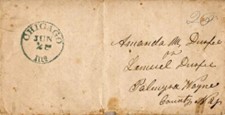
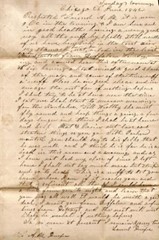
In the letter, Lemuel Jr. wrote of being in good health. He wrote of his travels from Buffalo to Chicago, having “head wind a good share of the way.” He encouraged his wife to “be in good cheer and encourage the rest.” He wrote of starting “tomorrow morning for the Kankakee.” He concludes his letter with—
This is enough to let you know where I am if it reaches you, and that is sufficient although if I could have a line from you tonight and learn that you was all well, it would be worth a good deal. I wrote you from Buffalo and a few lines from Detroit, and the next will most likely be verbal if nothing happens.
So no more at present. I remain yours,
Lemuel Durfee
Lemuel Jr. returned to his family. At that time, he was so respected by his Quaker friends that when Minister Peter Harris died, he was asked to inventory and itemize his estate. In so doing, Lemuel Jr. discovered that Peter owed a debt to him, and that Peter had in his possession many items belonging to the Farmington Quakers.
Lemuel Jr. turns to Politics
In 1857, Lemuel Jr. was elected supervisor of Macedon, a position equivalent to being elected mayor of the town. He was re-elected to the same office in 1863. During his years of civic service, Lemuel Jr.’s net worth was estimated at $22,980 in real wealth and $10,000 in personal wealth. In 1864, he was elected to represent Macedon in the New York State Legislature. When he sought a second term, his real wealth was estimated at $33,000 and his personal wealth at $24,350. He was elected to a second term because “he was conscientious in his capacity as a law-maker, and won a name for honor and integrity.”[21]
While serving his second term in the New York Legislature, his wife Amanda died in January 1871. Her death was devastating to Lemuel Jr. It was said, “From this blow he never recovered.”[22] He left the state capitol and returned home to Macedon. In the Last Will and Testament of Amanda Durfee, Lemuel Jr. was referred to as “my beloved husband” and named as her executor. According to the will, Amanda bequeathed to her daughter Wealthy $2,000 and her “wearing apparel, household goods, furniture, and silver.” She also bequeathed money to her granddaughter as well as several nieces and nephews.[23]
On April 7, 1871, Lemuel Jr. died of a painful illness at age seventy.[24] His obituary reads—
Mr. Durfee was one of the most worthy and public spirited citizens of Wayne County, and the people of the entire State are indebted to him for his strenuous and unflinching opposition to the increase in fares of the New York Central Railroad. It was understood that if he had voted for the increase, he would have benefitted financially. Mr. Durfee was true to himself and his constituents.[25]
Another obituary notice reads—
Mr. Durfee was a good man, an excellent citizen and neighbor, and one of the largest and most successful farmers in the vicinity. His death was not unexpected, as he had been warned by previous attacks of the disease which produced his death, that his condition was critical.[26]
Lemuel Jr.’s funeral was held at his palatial residence “and attended by nearly everyone in the neighborhood, a significant indication of the regard and esteem in which he was held.”[27] Lemuel Jr. was buried on April 10, 1871 in the Palmyra City Cemetery (not the Durfee Quaker Cemetery on his father’s land). In his Last Will and Testament, Lemuel Jr. bequeathed to his daughter Wealthy real and personal wealth, including “all books.” To his grandchildren and extended family, Lemuel Jr. bequeathed a portion of his real and personal wealth.
Child of Lemuel Jr. and Amanda Durfee
1. Wealthy C. Wright Durfee (October 6, 1831–February 28, 1920). She was born in Marion, Wayne County, New York. She married Marvin Hill on January 1, 1856 in Macedon Centre, New York. She died in Clifton Springs, Ontario County, New York and was buried in the Palmyra City Cemetery.
[1] In the Lemuel Durfee Sr. Family Bible are the names and birthdates of each child. Copies of the bible pages are housed in the Palmyra Community Library.
[2] Cook, Palmyra and Vicinity, pp. 192–193.
[3] “Brothers walked from Albany to Palmyra in Quest of Land,” Newspaper clipping.
[4] “Married,” Ontario Repository [Canandaigua, NY]. Newspaper Clippings. In author’s possession.
[5] Lucy Mack Smith, History, 1845, in Joseph Smith Papers.
[6] Lucy Mack Smith, History, 1845. Joseph Smith Papers.
[7] Wills, “Book A, 225, Wayne County Clerk’s Office, Lyons, NY. The Last Will and Testament of Lemuel Durfee Sr. is housed in the Wesley Preston Walters Manuscript Collection at the PCA Historical Archives and Manuscript Repository for the Continuing Presbyterian Church.
[8] Lucy Mack Smith, History, 1845. Joseph Smith Papers.
[9] Lemuel Durfee Sr. Bible.
[10] Vogel, Early Mormon Documents, 3:428.
[11] Donald L. Enders, “The Joseph Smith, Sr., Family: Farmers of the Genesee,” in Black and Tate, Joseph Smith: The Prophet, the Man, pp. 213–215.
[12] Lemuel Durfee Probate Papers, 1830 and Nathan Piece Docket Book, 1830, in Vogel, Early Mormon Documents, 3:429.
[13] “Marquardt: Historical Setting of Mormonism in Manchester,” p. 86; Probate Papers, Box 053, filed by executors Oliver Durfee and Lemuel Durfee, Jr., filed on January 22, 1830 in the Surrogate’s Court, Wayne County Courthouse, Lyons, NY.
[14] E. B. Grandin Diary, 1831–1841.
[15] E. B. Grandin Diary, 1831–1841.
[16] E. B. Grandin Diary, 1831–1841.
[17] E. B. Grandin Diary, 1831–1841.
[18] Howe, Mormonism Unvailed, pp. 366–367.
[19] Howe, Mormonism Unvailed, pp. 366–367.
[20] US Federal Census, 1840.
[21] “Death of Hon. Lemuel Durfee.” Newspaper Clipping, in Durfee Scrapbook #2, 1864–1875.
[22] “Death of Hon. Lemuel Durfee.” Newspaper Clipping, in Durfee Scrapbook #2, 1864–1875.
[23] Last Will and Testament of Amanda Durfee in New York Probate Records, Wayne County, NY, 1870–1874.
[24] Last Will and Testament of Amanda Durfee in New York Probate Records, Wayne County, NY, 1870–1874.
[25] Last Will and Testament of Amanda Durfee in New York Probate Records, Wayne County, NY, 1870–1874.
[26] “Died,” Newspaper Clipping, in Durfee Scrapbook, vol. 2, 1864–1875.
[27] Buffalo Daily Courier, 25 April 1871, in Durfee Scrapbook, vol. 2, 1864–1875.
